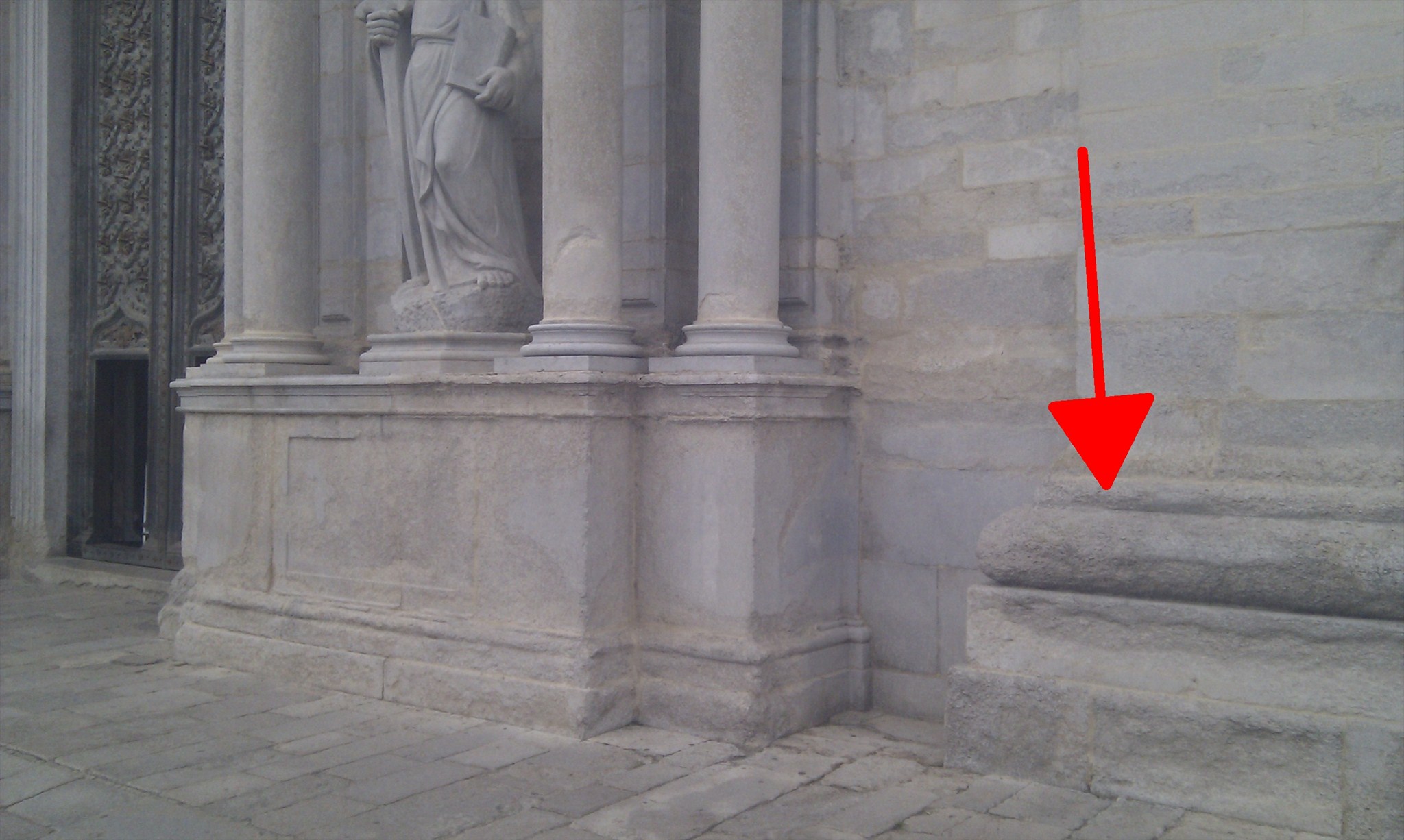
CATALÀ
Part de la catedral –igual que molts altres edificis emblemàtics del barri vell de la ciutat– fou construïda amb el que es coneix com pedra de Girona. La pedra de Girona és una pedra calcària de tonalitat grisosa que es trobava en abundància en afloraments pròxims a la ciutat; de fet, tot un barri de Girona ha heretat el nom de les instal·lacions d'extracció d'aquest tipus de pedra, el barri de les Pedreres. Està formada principalment per calcita o carbonat de calci (CaCO3) en un 80-90%, i en menor mesura per feldspat, quars i dolomita. [2][4]
La pedra de Girona té una característica que la fa molt especial i que s'aprecia visualment de manera molt ràpida. Té una gran presència de fòssils en forma de llentia (fòssils lenticulars) que li donen un aspecte molt característic. Aquests animals fossilitzats eren marins, vivien a poca profunditat en aigua rica en calci i havien estat molt abundants als mars i oceans tropicals de la Terra. No tenen descendents vius: es van extingir fa 25 milions d'anys. Estaven formats per una sola cèl·lula, i la part fossilitzada que es pot veure avui en dia a la pedra de Girona és la seva closca, que es podria equiparar al seu esquelet. Es desplaçaven amb uns falsos peus (pseudòpodes). [3][4]
Amb la informació que podeu trobar a les referències sereu capaços de respondre a les següents preguntes:
- Quin és el nom científic d'aquest protozou marí fossilitzat que està present a la pedra de Girona?
- En quina època geològica van viure aquests animals marins? Quin lapse de temps engloba aquesta època?
Pugeu els esglaons fins la façana de la catedral. Mentre ho feu, mireu als vostres peus i veureu la característica pedra de Girona, que també es pot observar en molts altres indrets de la ciutat. A la façana de la catedral, fixeu-vos en la zona assenyalada a la següent foto, a la dreta de l'entrada a la catedral, i veureu que la pedra calcària està molt erosionada: és un bon lloc per observar i tocar els fòssils lenticulars que la formen.

Responeu a les següents preguntes pràctiques:
- Aproximadament, quants fòssils lenticulars es poden trobar en una superfície de 10 cm x 10 cm?
- Aproximadament, quin diàmetre tenen els fòssils lenticulars d'aquesta pedra concreta?
Si podeu i voleu, pengeu una foto vostra amb els fòssils!
Envieu les respostes a geoarnautil@gmail.com .
REFERÈNCIES
[1] http://ca.wikipedia.org/wiki/Catedral_de_Girona
[2] http://www.pedresdegirona.com/itinerari_pedra_1.htm
[3] http://ves.cat/hkNu
[4] http://www.ub.edu/entornsweb/geoflaix/documents/modul1/m1_01_calc_num.pdf
ENGLISH
You find yourself in front of the cathedral of Girona, the biggest temple of the province of Girona. Its construction began in 1312 and ended during the 18th century. The cathedral has the widest gothic nave of the world (with 22.98 meters), and the second widest nave of the world in any architectural style after St. Peter's Basilica in Vatican City. [1]
Part of the cathedral –as well as other emblematic buildings of the old part of the city– was built with what's known as Girona stone (or, in Catalan, pedra de Girona). Girona stone is limestone with a gray tone which was found in abundance in outcrops in the surroundings of the city; in fact, a whole neighborhood of Girona inherited its name from the extraction facilities of this kind of stone, the neigborhood of les Pedreres. The Girona stone is formed mainly by calcite (CaCO3) in a 80%-90% proportion, and the rest is feldspar, quartz and dolomite. [2][4]
The Girona stone has a special characteristic which may be quickly visually appreciated. It has a big presence of lenticular fossils. Those fossilized animals were marine, they lived in low depth in calcium-rich water and they were really abundant in tropical oceans and seas of the Earth. They don't have any living descendents: they became extinguished 25 million years ago. They were formed by a single cell, and the fossilized part we can see nowadays in the Girona stone is their shell, which can be understood as their skeleton. They moved with the help of fake feet (pseudopodia). [3][4]
With the information available in the references you will be able to answer the following questions. Note to English geocachers: the references are in Catalan, you can either use Google translator or search for your own sources. I promise the questions are easy :-) check the hint!
- What's the scientific name of this fossilized marine protozoa which we can see in the Girona stone?
- In which geological epoch did those marine animals live? During which years did this epoch last?
Go up the stairs until you reach the facade of the cathedral. As you do so, look down to your feet and you will be able to see the characteristic Girona stone, which you can also see in other spaces of the city. In the cathedral's facade, take a look at the marked zone of the wall in the photo below, next to the main entrance; you will see that the limestone is very eroded, so it's a good place to observe and touch the lenticular fossils which form it.

Answer the following practical questions:
- Approximately, how many lenticular fossils can we count in a 10 cm x 10 cm area?
- Approximately, which diameter do those lenticular fossils have in this particular stone?
If you can and want, attach a picture of yourself with the fossils!
Send your answers to geoarnautil@gmail.com .
REFERENCES
Note: again, those are in Catalan, but the questions are easy enough to figure the answers out!
[1] http://ca.wikipedia.org/wiki/Catedral_de_Girona
[2] http://www.pedresdegirona.com/itinerari_pedra_1.htm
[3] http://ves.cat/hkNu
[4] http://www.ub.edu/entornsweb/geoflaix/documents/modul1/m1_01_calc_num.pdf